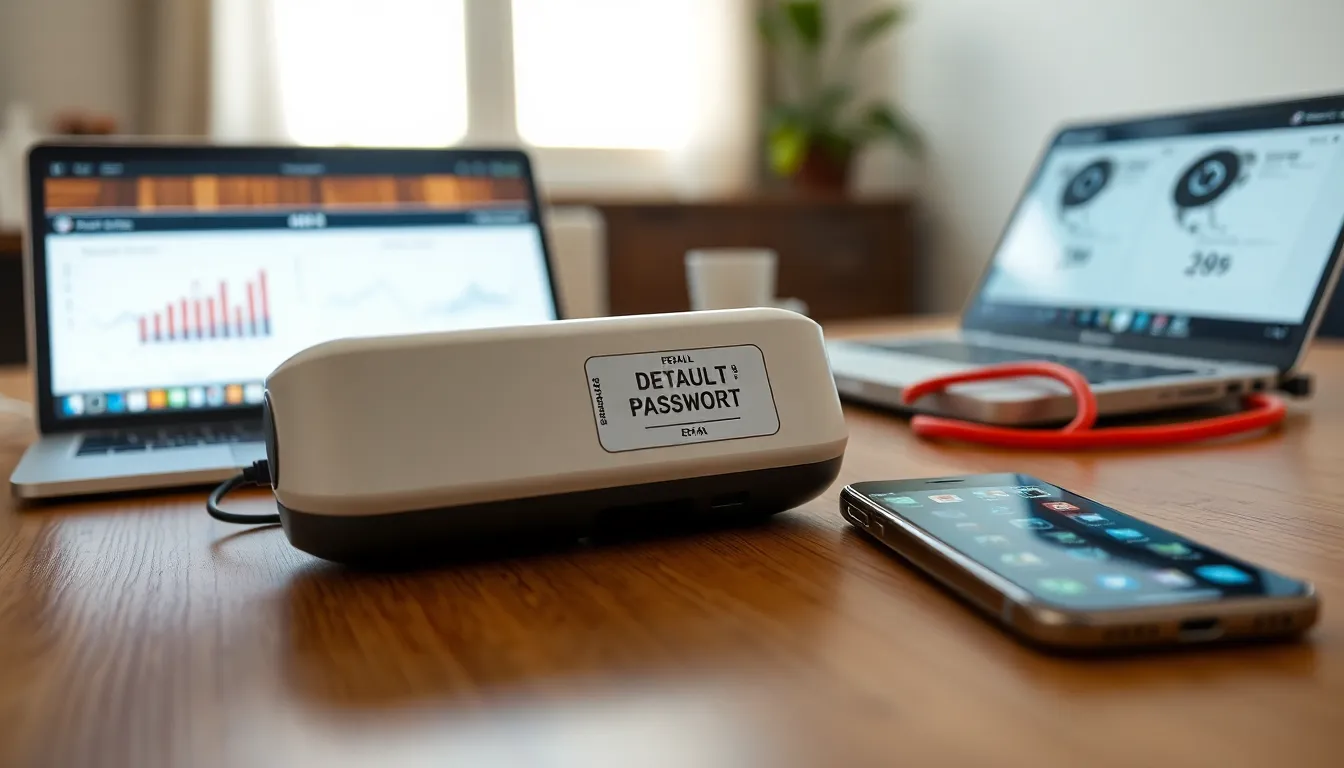In a world where your toaster might just be plotting against you, the Internet of Things (IoT) has transformed everyday devices into smart companions. But while these gadgets make life easier, they also open the door to a whole new realm of security risks that could make even the bravest tech enthusiast sweat. Imagine a hacker turning your fridge into a rogue ice-cream dispenser—hilarious, right? But the reality is far less funny.
As more devices connect to the internet, the potential for cyber threats skyrockets. From smart homes to wearable tech, every connected device is a potential entry point for cybercriminals. Understanding these risks is crucial for anyone who wants to keep their digital life—and their snacks—safe. Buckle up as we dive into the wild world of IoT security risks and learn how to outsmart those sneaky cyber villains.
Table of Contents
ToggleOverview of IoT Security Risks
IoT devices significantly enhance convenience but introduce critical security risks. Many smart gadgets lack robust security measures, leaving them vulnerable to cyberattacks. Cybercriminals exploit these weaknesses, targeting personal data, privacy, and even physical safety.
Unsecured devices create backdoor entry points into home networks. Many users neglect to change default passwords, making it easier for attackers to gain access. Data privacy becomes a significant concern when connected devices collect sensitive information without adequate safeguards.
Lack of standardization in IoT security practices exacerbates vulnerabilities. Manufacturers often prioritize device functionality over security, resulting in devices that do not receive timely security updates. Consequently, outdated firmware can become a target for exploitation.
An increasing number of reported incidents illustrates the real risks associated with IoT. A 2021 report indicated that 98% of IoT devices contained vulnerabilities. As the number of connected devices grows, so does the potential attack surface for hackers.
Compromised IoT devices can be used in distributed denial-of-service (DDoS) attacks. Often, attackers use networks of infected devices to overwhelm services and disrupt operations. Such attacks remain a prevalent threat, underscoring the importance of securing IoT devices.
To minimize these risks, users and manufacturers must prioritize security measures. Implementing strong, unique passwords and regularly updating software can improve device safety. Awareness of IoT security threats fosters a more secure digital environment for everyone.
Common IoT Security Vulnerabilities

Understanding IoT security vulnerabilities is critical for safeguarding connected devices. Several key areas pose significant risks.
Device Authentication Issues
Device authentication problems frequently arise in IoT environments. Many devices utilize weak or default passwords, making unauthorized access easy. Users often neglect to change these defaults, allowing cybercriminals to gain control effortlessly. A lack of robust authentication protocols increases this vulnerability, as many devices do not support two-factor authentication. Attackers target these flaws to infiltrate private networks, leading to unauthorized data access and manipulation.
Insecure Data Transmission
Insecure data transmission remains a significant concern for IoT devices. Sensitive information communicated over unencrypted channels can be intercepted easily. Attackers leverage this weakness to monitor and extract personal data. Encryption is often overlooked during design, leaving data vulnerable during transfer. Many devices fail to employ secure communication protocols such as TLS, further heightening the risk of data breaches. Understanding these vulnerabilities is crucial for implementing effective security measures in IoT environments.
Potential Consequences of IoT Security Breaches
Understanding the possible outcomes of IoT security breaches is crucial for users and manufacturers alike. When these breaches occur, the ramifications can be severe.
Data Theft and Privacy Violations
Compromised IoT devices often lead to significant data theft and privacy violations. Personal information, including financial records and health data, may be accessible to cybercriminals. Attackers exploit weak authentication measures to gain unauthorized access to networks. Once inside, they can harvest sensitive data and use it for identity theft or fraud. A staggering 98% of IoT devices reportedly contain vulnerabilities, heightening the risk of exposure. Individuals and organizations face long-term impacts, such as loss of trust and financial loss, highlighting the importance of robust security measures.
Operational Disruption
Operational disruption represents another significant consequence of IoT security breaches. Cybercriminals can utilize compromised devices to conduct distributed denial-of-service (DDoS) attacks. Such attacks overwhelm systems and services, causing them to crash or become unreachable. When functioning devices are part of a larger attack, it can disrupt entire operations and supply chains. This disruption often results in lost revenue and decreased productivity. Organizations must prioritize security to prevent these security breaches and maintain effective operations. Investing in advanced security measures can significantly reduce risks associated with IoT vulnerabilities.
Strategies to Mitigate IoT Security Risks
To enhance the security of IoT devices, implementing robust strategies is essential. These measures help protect personal data and ensure device integrity.
Implementing Strong Authentication
Utilizing strong authentication methods is key to securing IoT devices. Many devices come with weak default passwords, leaving them vulnerable to unauthorized access. Adopting unique passwords for each device greatly reduces risks. Employing two-factor authentication further strengthens security by requiring an additional verification step. Manufacturers should prioritize robust authentication protocols during the design phase. Users must also be educated about the importance of periodically changing passwords to maintain security.
Regular Software Updates
Keeping software up-to-date helps safeguard IoT devices against vulnerabilities. Reports show that outdated firmware is frequently exploited due to unpatched security flaws. Users should regularly check for updates and install them promptly. Many manufacturers provide automated update features that users can enable. Regular updates not only protect devices but also enhance functionality. Staying proactive in this area significantly reduces the risk of a successful cyberattack.
Future Trends in IoT Security
Emerging trends in IoT security reflect the evolving landscape of connectivity and technology. Predictive analytics play a crucial role in identifying vulnerabilities before cybercriminals exploit them. Organizations increasingly invest in artificial intelligence to automate security protocols, enhancing real-time monitoring of devices.
Another trend involves the rise of zero-trust architecture, which assumes that threats exist both inside and outside a network. This approach encourages thorough verification of devices before granting access, significantly reducing the risk of unauthorized intrusions. Many firms prioritize adopting multi-factor authentication, moving beyond traditional username and password systems to establish stronger defenses.
The integration of blockchain technology offers promising solutions for securing IoT transactions and data integrity. By providing a decentralized, tamper-proof record of device interactions, blockchain enhances transparency and trustworthiness. As the adoption of smart devices accelerates, organizations must also emphasize the importance of user education regarding IoT risks and security practices.
Data privacy regulations are increasingly influencing IoT security measures. Compliance with regulations such as the General Data Protection Regulation (GDPR) necessitates that manufacturers implement robust security features in their devices. An ongoing trend involves the push towards standardization in IoT security practices, enabling a more uniform approach to tackling vulnerabilities across devices.
IoT device manufacturers are gradually shifting focus from functionality alone to cybersecurity enhancements. Many now prioritize security during product development, ensuring that devices undergo rigorous testing before reaching consumers. Data from 2021 indicates that 98% of IoT devices contained vulnerabilities. This statistic underscores the urgency for proactive measures as the number of connected devices continues to rise.
Improvements in security measures can reshape the IoT landscape, creating a safer environment for users. Continuous innovations in encryption methods promise to secure sensitive data during transmission, addressing significant concerns related to insecure data transfer. By remaining vigilant and adaptable, stakeholders can significantly reduce the risks associated with IoT devices.
The rise of IoT devices brings significant convenience but also introduces serious security challenges. As vulnerabilities continue to be exploited by cybercriminals, understanding these risks becomes essential for users and manufacturers alike. Prioritizing robust security measures can help mitigate potential threats and safeguard personal data.
The ongoing evolution of IoT security will require continuous innovation and user education. By adopting strong authentication practices and maintaining updated software, individuals can significantly enhance their protection. As the landscape evolves, embracing new technologies like artificial intelligence and blockchain will be crucial in building a secure future for connected devices.




